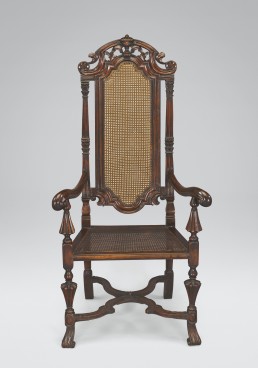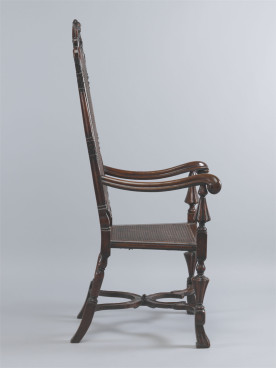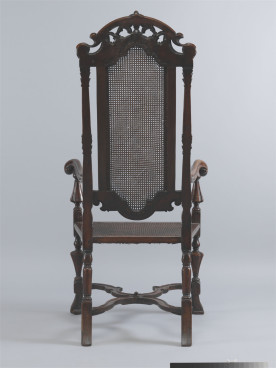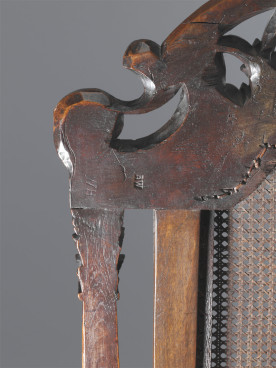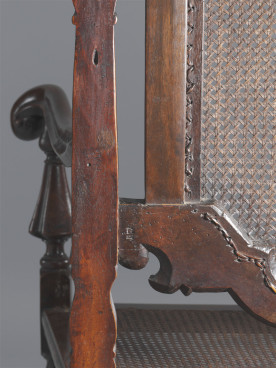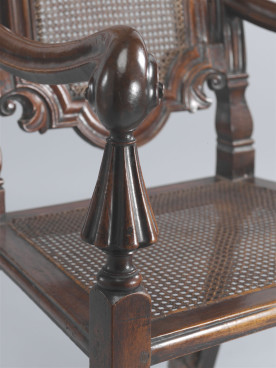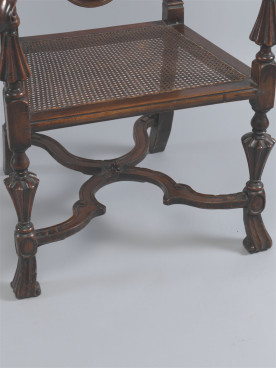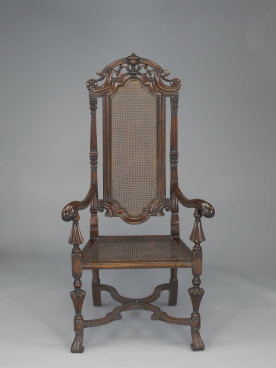Armchair, c.1710–15
Walnut and cane
The crest and lower back rail are stamped on the reverse ‘RW’, possibly the initials of the carver. The crest rail and left back upright are also stamped on the reverse ‘WH’, possibly the initials of the framer.
Adam Bowett Catalogue (19/08/2012)
Description
A walnut and cane armchair, c.1710-15. The high back has an arched, scrolling top rail centered by an urn over a shaped cane panel within a moulded frame, between square section fluted pillar uprights with leaf-carved capitals and out-turned moulded arms with scrolled terminals, raised on gadrooned baluster supports. The caned seat within moulded rails is raised on gadrooned baluster forelegs ending in scrolled feet and joined to the raked, turned back legs by a sinuous moulded X stretcher.
Dimensions
H: 53 “ (135cm) Seat height: 17” (43cm) W: 26 “ (66cm) D: 25” (64cm)
Materials
Walnut, cane
Dating criteria
This chair conforms in all aspects to the dating scheme proposed in Bowett (2002). Superimposed crest rail, shaped back panel and stylised pillar back posts all suggest a post 1700 date, as do the gadrooned balusters and scrolling front feet. The raked back leg almost certainly indicates a date of circa 1710 or later.
Construction
The crest rail is mortised onto the rear posts and the uprights of the back frame; the lower back rail is similarly mortised to the uprights of the moulded frame and jointed to the back posts with bare faced tenons. The arms are tenoned into the rear posts and mortised onto the arm supports. None of these joints are pegged. The seat rails are tenoned all round into the uprights and secured with single pegs. The stretcher is made in two S-shaped sections, half lapped in the centre and tenoned into all four legs. The gadrooned baluster arm supports and legs, and the scrolled feet are thicknessed with glued sections to the outer faces. The right arm terminal is also thicknessed whereas the left is carved from solid.
Marks or stamps
Crest rail and lower back rail are stamped on the reverse RW. The crest rail is also stamped WH on the left rear; the same stamp occurs the back of the left upright. These stamps are likely to be those of the carver and the chair framer respectively. The back of the crest rail shows evidence of having been used as a waster for the carver with numerous gouge marks, perhaps done as he carved the rest of the set.
Condition
There is a repaired break top right on the crest rail. The cane in the back is replaced and the back frame has been reinforced with a walnut strip down each side; the seat cane is also replaced. All pegs to joints at seat level are replaced. The stretcher has been reinforced with a walnut brace to its underside at the centre. There are also supports at each point where the stretcher meets the legs, although some of these are conceivably original.
Additional remarks
A good stylish, example.
References
Illustrated in Tobias Jellinek, Early British Chairs and Seats, 1500-1700, Woodbridge (2009), p. 163, pl.191.
For images of similar chairs, and a detailed discussion of design and chronology, see Adam Bowett, English Furniture from Charles II to Queen Anne, 1660-1714, Woodbridge (2002), pp. 260-271.
Provenance
Purchased Alastair Sampson, March 1992.

